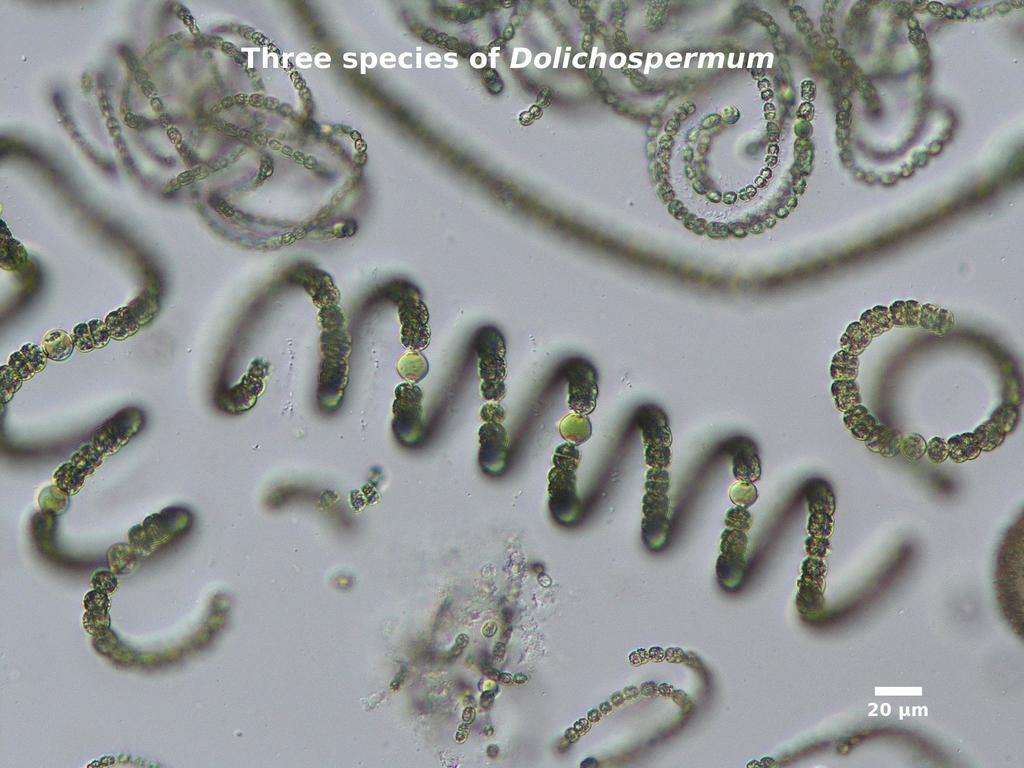CyanoHABs in our Community
Numerous species of cyanobacteria can pose significant problems in freshwater and brackish waters across Cape Cod, as well as the islands of Nantucket and Martha's Vineyard. Among the most common species in our region are Microcystis and Dolichospermum. Blooms of these species can result in illness or even fatalities among pets and livestock if they swim in or consume contaminated water. Similarly, humans are at risk of experiencing a range of symptoms, if they ingest, swim in, or inhale airborne toxins from CyanoHABs.
It's crucial for residents and visitors alike to be aware of the risks associated with CyanoHABs and take necessary precautions to avoid exposure.
Fact Sheets and Resources
 Cyanobacteria have a multi-phasic life cycle that plays a significant role in their bloom dynamics and impacts. Click on the figure to access an interactive graphic of the cyanobacteria life cycle.
Cyanobacteria have a multi-phasic life cycle that plays a significant role in their bloom dynamics and impacts. Click on the figure to access an interactive graphic of the cyanobacteria life cycle.
Microcystis

Microcystis spp. are among the most prevalent groups of harmful cyanobacteria affecting freshwater bodies in New England. These organisms form round colonies and can move vertically within the water column using internal gas vesicles. Some species within this genus produce toxins called microcystins, along with saxitoxins, which are also produced by other freshwater cyanobacteria species.
These toxins are released into the water when cells rupture, which can happen naturally at the end of a bloom or due to recreational activities. When humans consume contaminated water or food, cyanotoxins enter the body through the intestinal tract, affecting the liver, brain, and other tissues. This can lead to symptoms such as headaches, sore throat, vomiting, stomach pain, diarrhea, and blistering around the mouth. Dermal contact and inhalation can cause skin and nasal irritation, as well as exacerbate asthma.
Livestock and pets are also vulnerable to these health issues, with reports of dogs dying after swimming and ingesting toxins from licking their fur not uncommon. While Microcystis is a naturally occurring freshwater organism, it can proliferate significantly during warm periods and under nutrient-rich conditions.
The risk of harmful blooms is amplified by climate change, as warmer temperatures create favorable conditions for their growth. Additionally, nutrient loading from residential and commercial runoff contributes to bloom formation. When a regional water regulatory body issues an advisory for Microcystis, it is crucial to avoid entering, consuming, or participating in recreational activities on or near the water, and to prevent pets from drinking or swimming in these waters."
Dolichospermum
Dolichospermum, formerly known as Anabaena, is another common cyanoHAB culprit in New England waters. Cells form filamentous chains, notably with large gas vesicles that allow the cyanobacteria mats to move up and down in the water column in search of favorable growth conditions. Dolichospermum cells also have the capability of forming heterocysts and akinetes, the former being a cell that fixes nitrogen and enables the population to continue when local nitrogen is depleted, and the latter being a thick-walled cyst that can rest dormant in the sediment until conditions are ripe for another bloom. Like Microcystis, Dolichospermum produces microcystin, causing the symptoms listed above. Some strains of Dolichospermum produce more diverse toxins, including alkaloids and lipopolysaccharides that function as neurotoxins, cytotoxins, and dermatotoxins. The best way to prevent exposure to these toxins is to avoid contact with and consumption of water where a bloom is occurring, or has recently taken place.

As with Microcystis, eutrophication and warmer waters due to climate change both induce and exacerbate Dolichospermum blooms. A secondary impact of climate change, increased variability in rainfall, is likely to promote Dolichospermum prevalence in freshwater communities as the unique akinete survival strategy allows the species to survive droughts and floods that other less toxic species cannot withstand.
